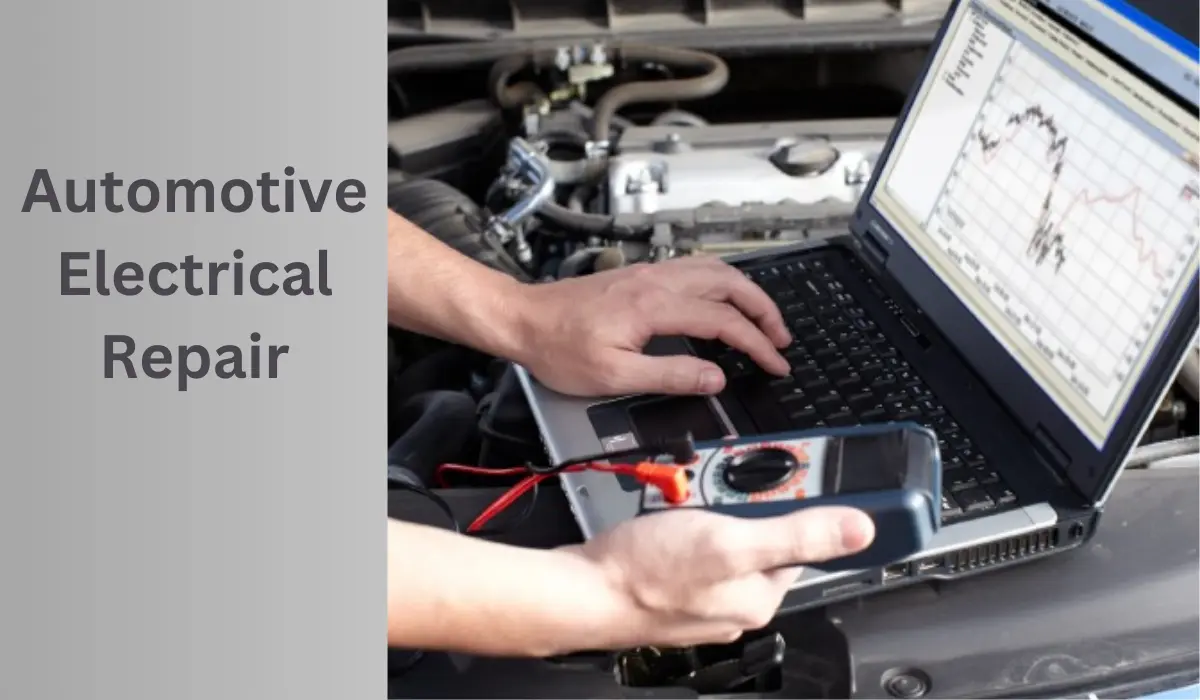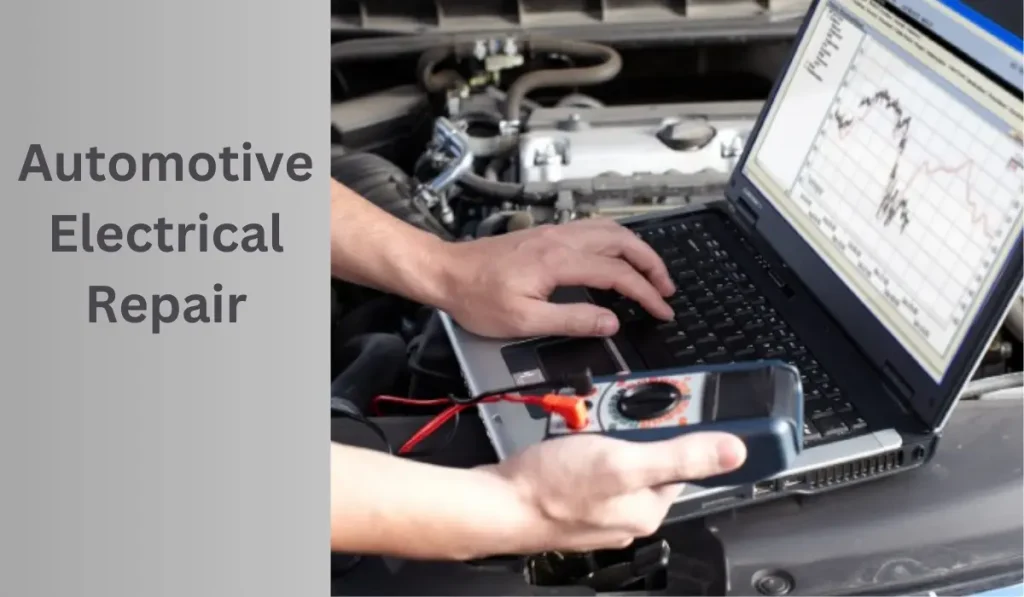In today’s technologically advanced automotive landscape, vehicles have complex electrical systems that control various functions, from engine management to comfort features. However, the potential for malfunctions comes with complexity, necessitating skilled electrical repair. Understanding automotive electrical systems and mastering the art of diagnosis and repair is crucial for both professional mechanics and DIY enthusiasts. This article aims to provide a comprehensive guide to automotive electrical repair, covering key concepts, common issues, and repair techniques.
Understanding Automotive Electrical Systems:
In modern automotive engineering, electrical systems stand as the nerve center, orchestrating a symphony of functions essential for vehicle operation. Understanding these systems is vital for mechanics, engineers, and enthusiasts alike. This article delves into the core components and principles that make automotive electrical systems tick.
1. The Power Source: Battery
At the heart of every vehicle’s electrical system resides the battery. Serving as the initial power source, the battery kick-starts the engine and provides electricity for various components when the engine is off. Maintaining the battery’s health through regular inspections and proper charging is crucial to avoid unexpected failures.
2. Charging the System: Alternator
While the battery initiates the electrical flow, the alternator takes over once the engine is running. This component converts mechanical energy from the engine into electrical power, replenishing the battery and powering the vehicle’s electrical systems. A malfunctioning alternator can lead to battery drain and electrical issues.
3. Starting the Engine: Starter Motor
When you turn the key (or push the button), the starter motor leaps into action, engaging with the engine’s flywheel to initiate combustion. Without a functional starter motor, your vehicle won’t even whisper to life.
4. The Backbone: Wiring Harnesses
Connecting every electrical component in the vehicle is a network of wiring harnesses. These intricate bundles of wires ensure the seamless flow of electricity, transmitting signals and power to various systems and sensors throughout the vehicle.
5. Brain and Sensors: Control Modules
Modern vehicles are equipped with an array of sensors and control modules that monitor and manage crucial functions. These modules collect data from sensors, analyze it, and make real-time adjustments to optimize performance, efficiency, and safety. From engine management to climate control, these electronic brains are the silent conductors of the automotive orchestra.
6. Conductor of Power: Fuses and Relays
To safeguard the electrical system from overload and short circuits, fuses and relays act as gatekeepers, controlling the flow of electricity. Fuses are sacrificial components that break the circuit when subjected to excessive current, while relays act as remote switches, controlling high-current circuits with minimal power.
Common Electrical Issues:
Electrical issues are among the most common problems encountered in automotive maintenance and repair. Here are some of the prevalent electrical issues faced by vehicle owners and technicians:
Dead Battery:
Cause: Batteries have a limited lifespan and can degrade over time. Leaving lights or accessories on when the engine is off can also drain the battery.
Symptoms: Difficulty starting the engine, dimming lights, and clicking sounds when turning the key.
Solution: Recharge the battery if possible or replace it if it can no longer hold a charge.
Faulty Alternator:
Cause: The alternator may fail due to worn-out brushes, faulty voltage regulators, or worn-out bearings. A damaged alternator can lead to insufficient charging of the battery.
Symptoms: Warning lights on the dashboard, dimming headlights, frequent battery replacements.
Solution: Replace the alternator to restore proper charging of the battery.
Starter Motor Issues:
Cause: Wear and tear over time can lead to starter motor failure. Corrosion, worn-out solenoids, or damaged wiring can also contribute to starter motor problems.
Symptoms: Clicking sound when attempting to start the engine, no response when turning the key.
Solution: Replace the starter motor if it fails to engage or function properly.
Wiring Problems:
Cause: Wiring harnesses can suffer from corrosion, abrasion, or damage due to environmental factors or age. Poor connections or loose wires can also disrupt the electrical flow.
Symptoms: Intermittent electrical issues, malfunctioning components, blown fuses.
Solution: Inspect and repair damaged wiring, secure loose connections, and replace corroded components as needed.
Blown Fuses:
Cause: Fuses protect electrical circuits from overload by breaking the circuit when excessive current flows through them. Overloading circuits, short circuits, or faulty components can cause fuses to blow.
Symptoms: Inoperative electrical components, such as lights, power windows, or radio.
Solution: Identify and repair the underlying cause of the electrical overload, then replace the blown fuse with one of the correct amperages.
Faulty Switches and Relays:
Cause: Switches and relays can wear out over time or become corroded, leading to malfunctioning electrical systems.
Symptoms: Inoperative components controlled by the switch or relay, such as lights, fans, or windshield wipers.
Solution: Test switches and relays for proper functionality, and replace them if necessary to restore operation.
Sensor Malfunctions:
Cause: Sensors, such as those for engine management, emissions control, or ABS systems, can fail due to damage, corrosion, or electrical faults.
Symptoms: Warning lights on the dashboard, poor engine performance, erratic behavior of electronic systems.
Solution: Diagnose the specific sensor causing the issue using diagnostic tools, and replace it if necessary.
Addressing these common electrical issues promptly and accurately is essential to maintain the reliability, safety, and performance of your vehicle. Whether you’re performing DIY repairs or seeking assistance from a professional mechanic, understanding the symptoms and solutions for these problems can help ensure a smoother driving experience.
Also Read
Diagnostic Techniques:
Diagnostic techniques play a crucial role in identifying and resolving automotive electrical issues effectively. Here are some commonly used diagnostic techniques:
Visual Inspection:
Conduct a thorough visual inspection of the vehicle’s electrical components, wiring harnesses, connectors, and fuse boxes.
Look for signs of damage, corrosion, loose connections, or melted insulation.
Check for worn-out or frayed wires, particularly in areas prone to rubbing or bending.
Multimeter Testing:
Use a multimeter to measure voltage, resistance, and continuity in electrical circuits.
Test the battery voltage to ensure it is within the recommended range.
Check for voltage drops across connections and components to identify areas of high resistance.
Test continuity in wires and connectors to verify proper electrical pathways.
Scan Tool Diagnostics:
Connect a diagnostic scan tool to the vehicle’s onboard diagnostic (OBD) port.
Retrieve trouble codes stored in the vehicle’s computer systems to identify specific issues.
Monitor live data streams to analyze sensor readings, engine parameters, and system operation.
Perform component actuation tests to activate and test various electrical components.
Circuit Testing:
Use wiring diagrams and circuit schematics to trace electrical pathways and identify components in a circuit.
Test individual circuits for continuity, ensuring that electricity can flow uninterrupted.
Use a test light or power probe to check for power and ground signals at various points in the circuit.
Use a circuit tester or oscilloscope to analyze waveform patterns and signal integrity.
Component Testing:
Test individual electrical components, such as relays, switches, sensors, and motors, to verify their functionality.
Use the appropriate testing procedures and tools, such as load testers, resistance tests, or voltage drop tests.
Compare test results to specifications provided by the vehicle manufacturer to determine if a component is faulty.
Perform bench tests on removed components, if possible, to isolate and confirm the source of the problem.
Voltage Drop Testing:
Perform voltage drop tests across critical connections, such as battery terminals, grounds, and high-current circuits.
Measure the voltage drop between the power source and the load to identify areas of excessive resistance.
Compare measured voltage drops to specifications to determine if connections are within acceptable limits.
Address high-resistance connections by cleaning, tightening, or repairing damaged terminals and connectors.
By employing these diagnostic techniques systematically, automotive technicians can pinpoint electrical issues accurately and efficiently. Whether diagnosing a simple wiring problem or troubleshooting complex sensor issues, a methodical approach is essential for successful electrical diagnostics and repair.
End Words
Automotive electrical repair requires a combination of technical knowledge, diagnostic skills, and practical experience. Whether you’re a professional mechanic or a DIY enthusiast, understanding the fundamentals of automotive electrical systems, diagnosing common issues, and employing effective repair techniques are essential for keeping vehicles running smoothly. By mastering these skills, you can tackle electrical problems with confidence and ensure the continued reliability and performance of your vehicle.





